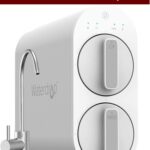Disconnect the power to the water softener.
Water softeners are devices that are installed in homes to remove minerals from hard water. This process is important to prevent these minerals from damaging plumbing fixtures and appliances. While most water softeners will require professional installation, they can be disconnected by following a few simple steps.
1. Turn off the power to the water softener. This can usually be done by flipping a switch on the unit itself. If there is no switch, locate the circuit breaker that controls the power to the unit and flip it to the “off” position.
2. Cut the power supply to the water softener. This will usually be a small wire that is connected to the unit.
3. Disconnect the water line from the water softener. This line will likely be made of plastic or metal and will be connected to the unit with a nut or screw.
Install a Home Water Filter & Get "Unlimited Safe Drinking Water" For Decades
Get Upto 55% Discount With a Lifetime Warranty & 6-Months Money Back Guarantee Free Shipping
SpringWell Water Filtration Systems: 100% American-Made & NSF Certified Water Filters and Water Softeners
4. Remove the brine tank from the water softener. This tank is typically located above the unit and holds the salt that is used to clean the unit.
5. Remove the water softener from its location. This may require disconnecting additional hoses or wires.
6. Take the water softener to a local recycling center. Most centers will accept these devices and recycle them properly.
How Do I Know When To Disconnect My Water Softener?
When the water from your tap is no longer soft, it is time to disconnect your water softener.

If your water tastes salty or you notice mineral buildup on fixtures, it’s time to disconnect your water softener. These are signs that the softener is no longer working and needs to be replaced.
If you have a salt-based water softener, you’ll need to add salt to the unit on a regular basis. Over time, the salt will break down and no longer be effective. If you notice that your water isn’t as soft as it used to be, it’s probably time to add more salt to the unit.
If you have a potassium-based water softener, you won’t need to add salt. However, the potassium can break down over time and become less effective. If your water doesn’t seem as soft as it used to be, it’s probably time to replace the potassium.
You should also disconnect and clean your water softener every few years to prevent mineral buildup and keep it working properly.
How Do I Properly Disconnect My Water Softener?
To properly disconnect your water softener, disconnect the power supply, bypass the unit, and disconnect the water line.
Water softeners are an important part of many homes, especially those with hard water. Hard water can cause a number of problems, including clogged pipes and fixtures, and scale buildup on appliances. A water softener helps to remove the minerals that cause hard water, making it easier to keep your home clean and your appliances working properly.
If you’re moving or need to disconnect your water softener for any reason, it’s important to do so properly. Improperly disconnecting a water softener can damage the unit or cause it to malfunction. Here’s a step-by-step guide to properly disconnecting your water softener:
1. Turn off the power to the unit. Most water softeners have an internal power switch that must be turned off before disconnecting the unit.
2. Drain the unit. Before disconnecting any hoses or pipes, you’ll need to drain the water softener. This can be done by opening the drain valve and running a hose from the drain outlet to a nearby drain or sewer.
3. Disconnect the hoses and pipes. Once the unit is drained, you can disconnect the hoses and pipes that are connected to it. Make sure to label the hoses and pipes so you know where they go when you’re ready to reconnect the unit.
4. Move the unit. Once everything is disconnected, you can move the unit to its new location.
5. Reconnect the hoses and pipes. Once the unit is in its new location, you can reconnect the hoses and pipes. Make sure to check all the connections before turning on the power to the unit.
Following these steps will ensure that your water softener is properly disconnected and won’t be damaged in the process.
FAQ
What Tools Do I Need To Disconnect My Water Softener?
What Are The Steps To Disconnect My Water Softener?
1. Turn off the power to the unit.
2. Drain the brine tank by opening the brine tank valve and draining the water into a bucket.
3. Disconnect the brine tank from the unit.
4. Disconnect the fresh water inlet and outlet lines from the unit.
5. Remove the unit from its location.
Now that you know how to disconnect a water softener, hopefully you don’t have any more questions. If you do, feel free to comment below.


